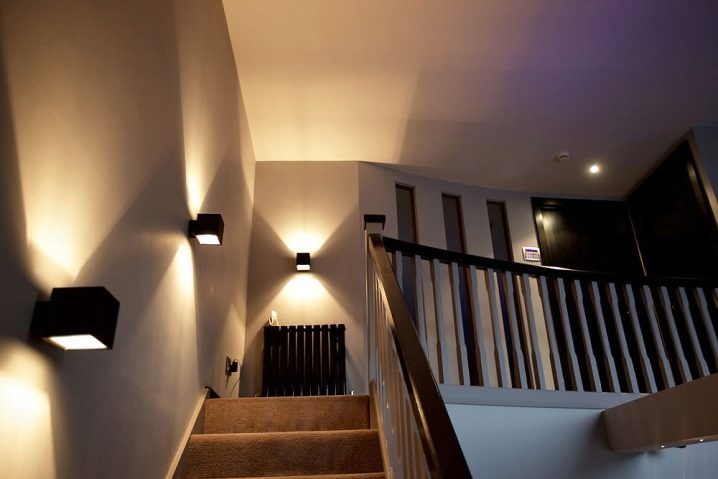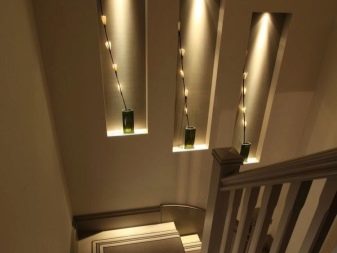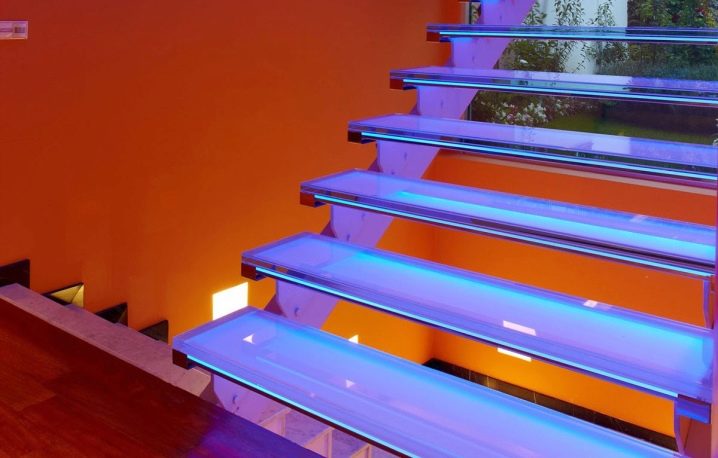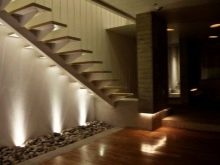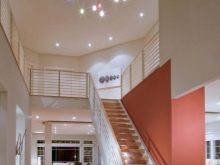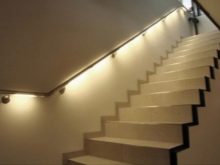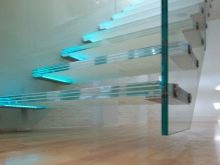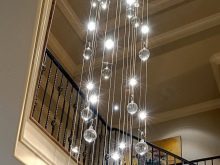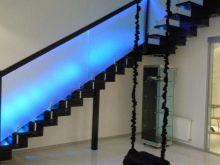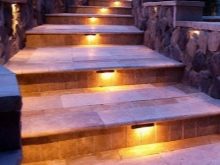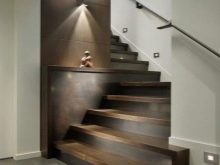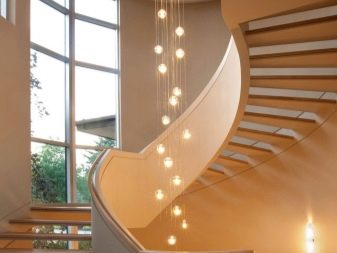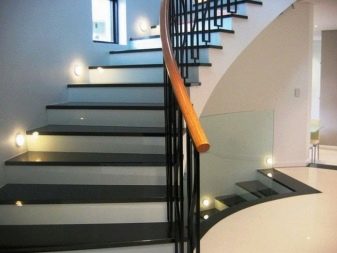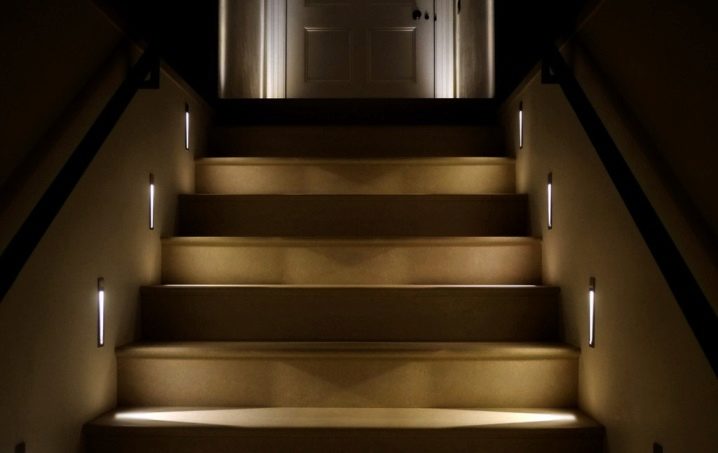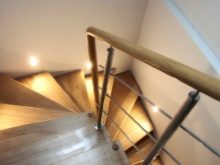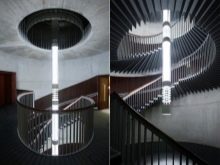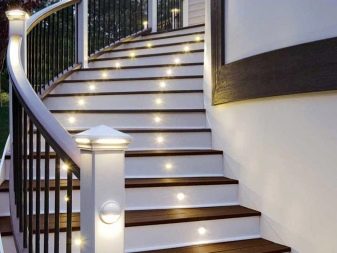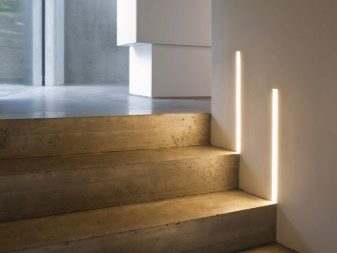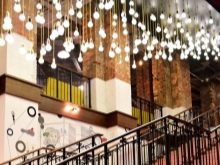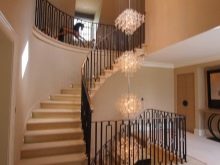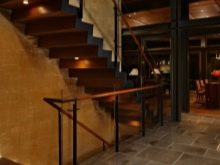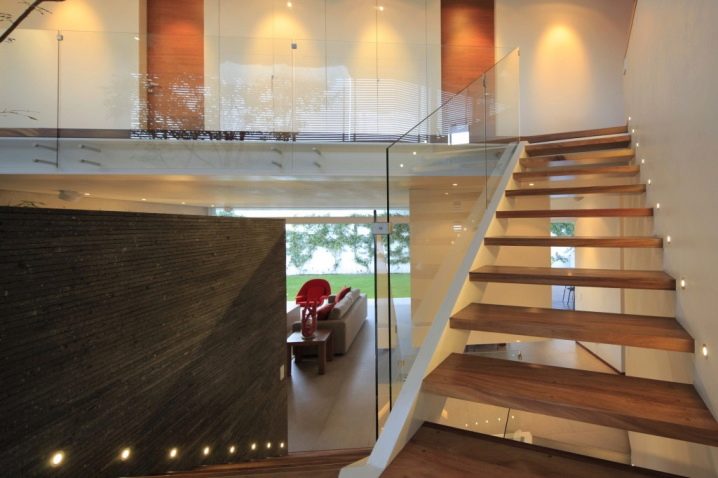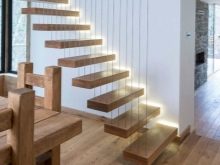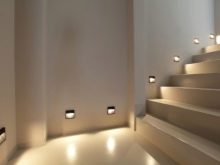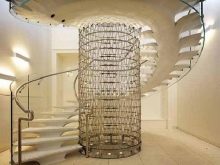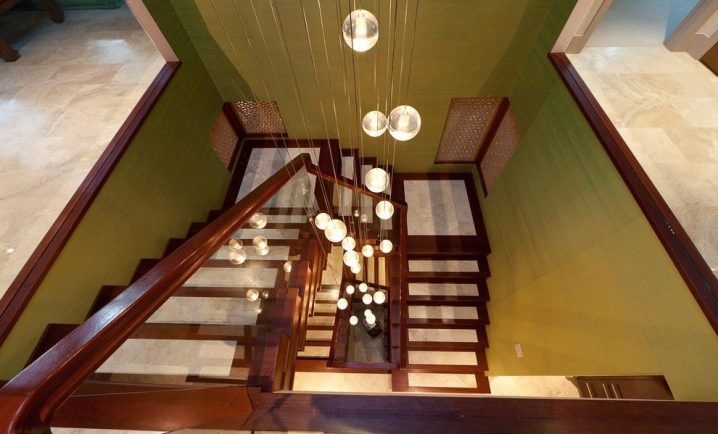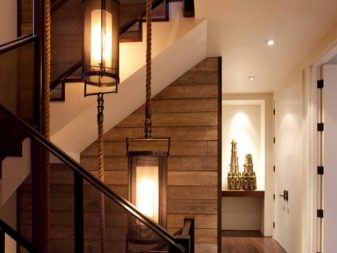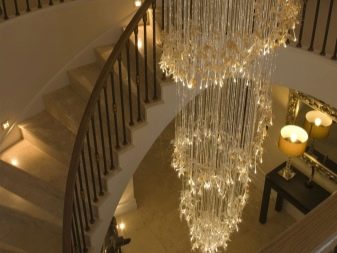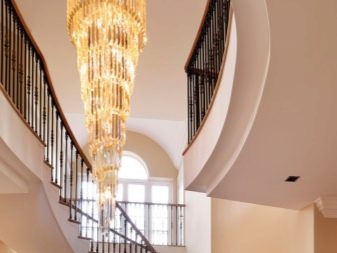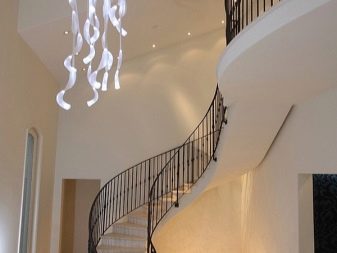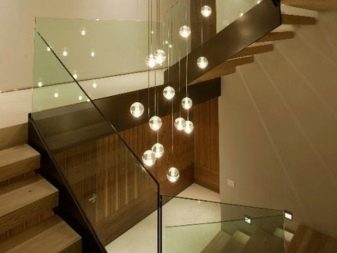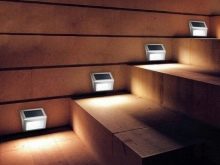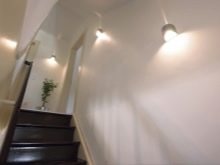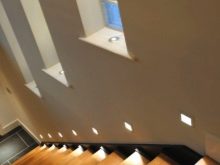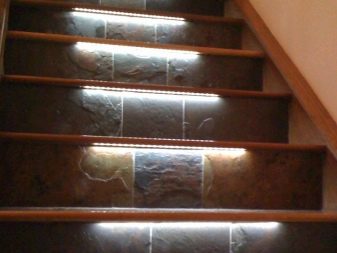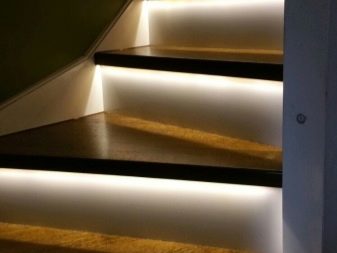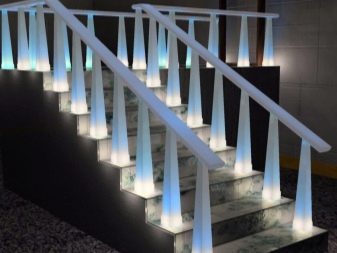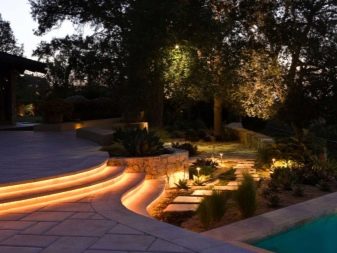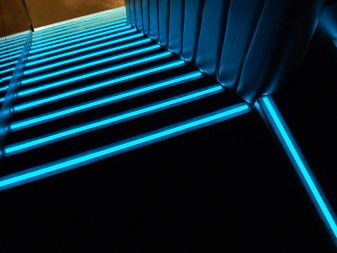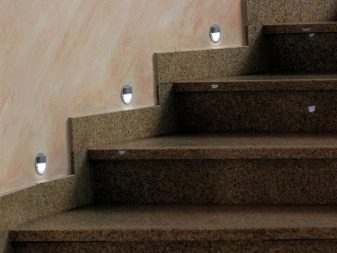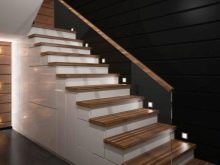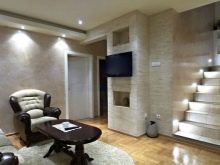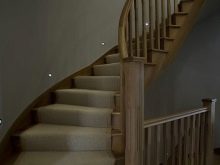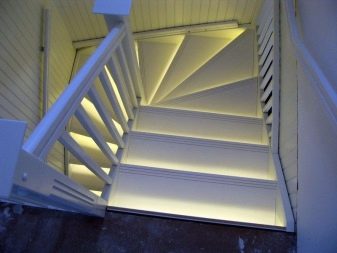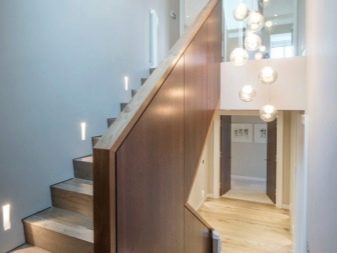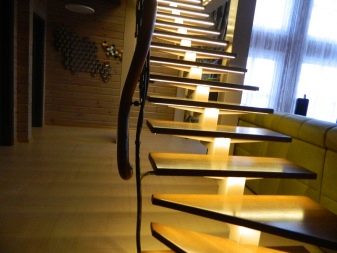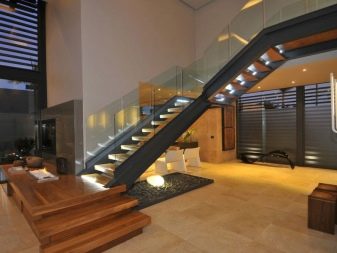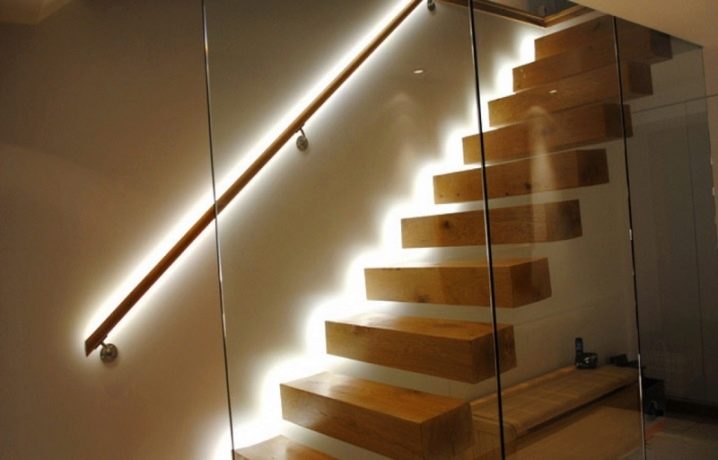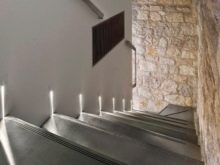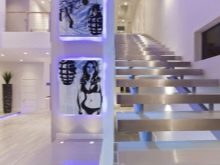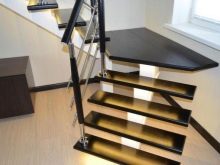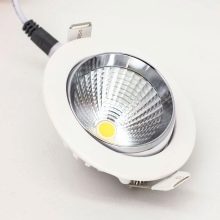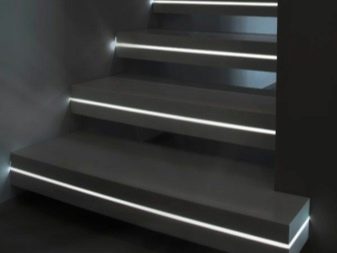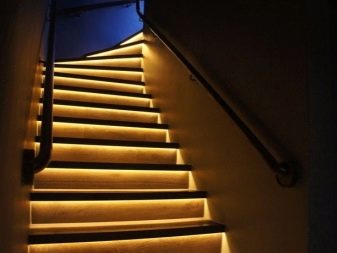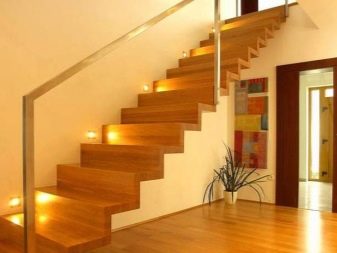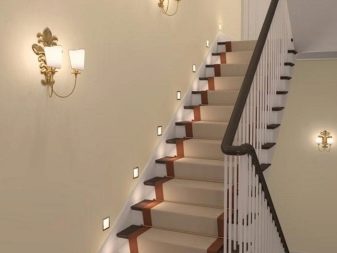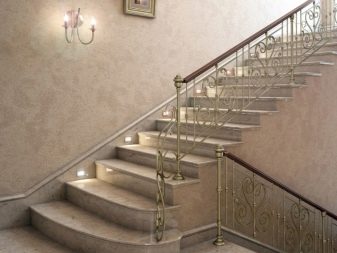Stair lights
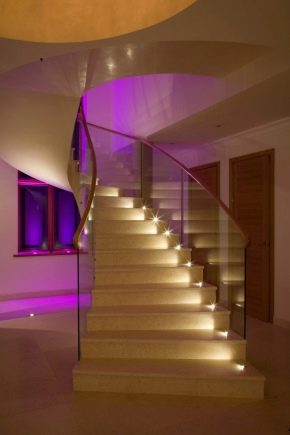
The ladder is not only a functional and useful design, but also an object of increased risk. Proof of this is a large percentage of household injuries sustained when interacting with these structural elements.
It is not enough just to equip a house with marches, you need to reduce the risks arising in the process of their use, to the minimum possible. It is important to bear in mind that moving under an inclination is always accompanied by some discomfort and is associated with a certain physical load.
There are universal solutions designed to increase the safety and comfort of the flight of stairs. One of these solutions - their coverage throughout. Let's talk about how to correctly plan the lighting of the stairs and what types of lighting devices will ensure the successful implementation of the task.
Benefits
Today, the lighting of auxiliary zones - corridors, halls and staircases is given the same importance as the sources of artificial light in the main rooms.
When it became customary to create a two-tier space and include stairs in the total living space of houses and apartments, they were no longer perceived as purely functional areas, but began to use decorative qualities to increase the attractiveness of the visual component of housing. At the same time, properly organized coverage of marches solves specific problems — functional, aesthetic, and psychological.
The main functions of light:
- creates the necessary degree of illumination, which contributes to the convenient and safe use of the flight of stairs for its intended purpose;
- provides psychological comfort of movement along the span, softening our perception of a closed space, which involves only two directions of movement, becoming a guideline;
- acts as a decorative element, contributing to the interior design;
- plays the formative role of organizing a useful area: if necessary, visually unites the staircase and the rest of the rooms, or separates it from them.
Lighting selection rules
To organize the lighting on the stairs, you need to take into account a number of points.
The location of the stairs inside / outside the residential facility
Constructions from the outside are illuminated with general lighting both throughout the household territory and locally. Powerful street lighting devices are usually compact models of floodlights or lanterns.
Lighting of the street type must meet increased requirements: be frost-resistant and withstand temperature fluctuations.
Lamps that illuminate the steps, attached to the construction of houses, independent supports, cable liner. Power is supplied by ground / underground cables.
The presence / absence of windows, stained glass
If the room has sources of natural light, during daytime the flight of stairs is well lit and even better in sunny weather. But they cease to fully satisfy the need for natural light when it is overcast or at dusk. Therefore, the lack of light is compensated by lighting.
In most cases, in the basements and attic windows is not provided. In the absence or lack of natural light, the problem is solved by diffused lighting, which will highlight the march around the clock.
Type of construction
It is logical that it is necessary to plan lighting of rectilinear, arc-shaped and curvilinear inclined structures in different ways. If, when equipping with a single-frame structure, it can be limited to illuminating its beginning and end with the help of automatic luminaires, then this is not enough for a spiral construction.
In this case, it is best to highlight the steps in order to ensure good visibility under your feet during descent or ascent.
Lift length
It is recommended to equip long staircase structures with diffused light fixtures in order to avoid an increased load on the organs of vision during long transitions.Short lifts are quite enough spotlights, as it does not affect the comfort and safety of the person walking.
Dimensions, design and number of lighting devices are determined individually, taking into account the specific conditions, the style of the staircase, the functional purpose of the premises in which they are located.
Kinds
In addition to sources of direct and diffused light, on the staircases and adjacent areas there are used lamps with reflected light and a combination of lighting fixtures of various types.
No matter which of the above options you use, It is important to observe the following requirements.:
- to achieve a uniform distribution of light throughout the length of the flight of stairs;
- to ensure good visibility of all the steps, which is possible with sufficient luminaire power;
- to provide the correct direction and intensity of the light fluxes: they should not be blind when climbing or descending.
Lighting devices are involved in the organization of general lighting, local (point) to create patches of light in the right places and decorative lighting, emphasizing the volume and depth of objects.When choosing lamps, the degree of illumination of the room, the directivity and brightness of the total luminous flux are taken into account.
Ceiling light features
In order to illuminate large, often ceremonial staircases with several spans and adjacent platforms, it is advisable to resort to the help of chandeliers with long hangings.
Due to the uniform distribution of light rays, the lighting is soft and does not irritate the eyes. Layered spiral models with an abundance of glass balls, in the form of a cascade of crystal "tears" or luminous columns give the marches an elegant and sophisticated look. The winning solution is a chandelier decorated with forging with brass or bronze frame parts in combination with a cast-iron march and wrought iron railings.
Chandeliers are often used to create an additional light accent in the area of the staircase, emphasizing the details of the inclined structure. They help out in a situation where the march is designed in the central part of the premises, which does not imply docking of the first span of its structure and the wall, so the ceiling lighting is the only option.
Features of wall lights
The most common way to organize the lighting of the staircase involves combination of lamps of different types, namely:
- near-surface models when the lamps are attached to the wall behind the back. Such a fixation option eliminates the possibility of changing the direction of light rays, since the ceiling lamps do not rotate. Advantages: the creation of a uniform diffused lighting and compact placement of lighting devices, which allows to decorate in a similar way, even very wide marches;
- sconce with bracket base, which provides the ability to mount lamps at different distances from the walls. This option of illumination is universal, as it organically complements any interior solution. In some models of sconces there is a turning mechanism for changing the direction of light;
- recessed fixtures, at the same time the minimum installation depth is 4 cm. The package includes stationary or movable heads that facilitate the change of the direction of the luminous flux.
The design of most models of recessed luminaires is focused on the interior design in modern styles hi-tech, techno, loft, where concise forms and austere look are welcome.There are two types of design of wall lamps (plafonds, lampshades, compositions of pendants): closed to create a uniform lighting of the march and open with a clear direction of the light flux up or down, parallel to the steps. Muffled lighting provides ceiling lamps made of glass, crystal, plastic and lampshades of their dense textiles, rice paper.
Local lighting: LED lights
Originally beat the individual elements of the staircase - the steps allow LED lighting. LED-backlight gives the design of marches expressiveness, simultaneously acting as an additional source of light. The vertical surface of the steps is equipped with separate overhead lights in the central or side part. An interesting option is when the luminaires “sink” inside the steps of a wide march by building in lamps in the immediate vicinity of the railing.
Arguments for the use of LEDs:
- attractive appearance;
- simple installation;
- long service life - on average 10 years;
- convenience of use - a remote control is provided for adjusting the intensity of the luminous flux and color;
- safety - the tape is powered by a 12 volt unit;
- profitable price;
- low power consumption and, consequently, the ability to save on payment for electricity.
Tapes are inserted into special profiles that protect the LEDs from contact with water, various kinds of dirt and mechanical damage.
Advantages of automatic marching
Occasionally, the use of stairs does not require the use of lighting devices in continuous operation. In such situations, set the automatic backlight with motion sensors, equipping all the stages of construction or one stage at the entrance / exit.
The advantages of automatic fixtures:
- save electricity;
- provide a comprehensive setting of lighting devices;
- look spectacular;
- solve the problem of finding switches at nightfall.
Motion sensors react to moving objects that fall within their coverage area, transmitting a signal to lighting systems, as a result of which they turn on. The light is switched off in the automatic mode, after a certain time since the moment of stopping the movement.
In other machines, acoustic sensors are provided that switch on the light in response to noise, which is produced by the steps of a person within the range of the device.In both types of machines there are light sensors that are responsible for switching on lamps in cases of insufficient illumination of the staircase.
Such devices successfully interact not only with classical models of lighting devices, but also with LED strips. If desired, the automata are adjusted so that the stage lights turn on gradually, as the user descends or ascends.
Backlight options
Planning for lighting in a cottage or a private house, requires careful study of details. Complicating the task is the need to highlight exactly the two-level space, where one or more marches are necessary. To create additional comfort, general lighting sources are combined with local ones. That implies the placement of lamps along the functional interface of marches and walls, maintaining the same pitch for detailed illumination of the steps.
Installing lights along the steps in a private house suggests several options for placing light sources:
- on the wall along the structure above the average human height: so they will not blindly go - once and touch the head - two;
- inside the wall at knee height;
- on the side of the steps to the second floor have lining spotlights;
- under the tread of each stage LED-tapes.
Often, additional lighting is required for the beginning or end of the staircase or railings. Therefore, the directional light fixtures equip the entrance / exit of the march, and provided it is of increased length, the light sources are placed all the way plus they use flexible fluorescent cords to illuminate the handrails. They are placed behind handrails along the rail guide.
Light control
Because of the design features of the stair spaces, the installation of conventional switches does not make sense, since they stand on the structures on one floor and leave them on the other. Switches with a switch function are relevant here. When the user gets up on the march, he turns on the light with the appropriate button, and when he has finished climbing, turns off the lights with another button, which refers to the same switch.
How the automatic illumination of the stairs with motion sensors works, see in the next video review.
Installing large ceiling lights - a reason to get a dimmer - a special regulator of the intensity of the level of illumination of the room from the muted light to the most bright.
There are timers that are able to turn off / turn off the light at regular intervals of time. But for private households, these devices are not particularly suitable, due to the large area of such buildings. Another thing motion sensors, about their capabilities, you already know.
How to choose?
To navigate in a huge range of lighting devices for lighting staircases, it is important to have an idea about the main types of lamps and their performance.
- Neon lights used to create a soft light that does not cast a shadow. With such lighting, you can safely move up the stairs both during the day and at night. Pros: the duration of operation. Cons: due to the fragility of the lighting element will require additional protection of the lamp from external influences.
- Halogen light sources provide good brightness and uniform distribution of luminous flux. Cons: strong heat, so it is important to eliminate the interaction of halogen lamps with the surface of other objects.Power surges provoke their rapid burnout.
- LED lamps occupy a leading position in the rating devices that illuminate the stairs. They are characterized by minimal heat and long service life. The popularity of LED luminaires is also due to the extensive possibilities of multi-colored design of structures of any height and shape.
To emphasize the beauty of wooden structures, yellowish light is used, in which wood will delight the eye with pleasant natural shades.
Metal products are transformed in bright white light, which, reflected from the metal surface, creates a fancy game of glare.
Beautiful interiors
The photo gallery contains examples of the organization of staircase lighting in city apartments and country houses:
- lighting the stairs in the cottage;
- lighting stairs to the second floor;
- original stage lighting;
- combined lighting.
